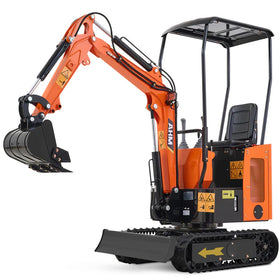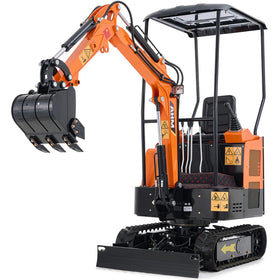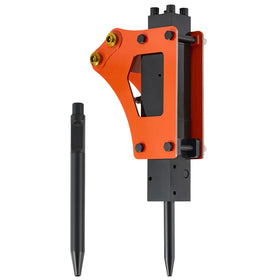Wondering whether buying a skid steer for business use is the right move? The skid steer business market is booming because these machines tackle multiple jobs that would otherwise require separate equipment or crews.
A 2020 study found that businesses using skid steer loaders for jobs that were previously done manually reported an average 4:1 return on investment. That's the kind of math that just makes sense and keeps your business flourishing. From landscaping to construction cleanup, choosing the correct mini skid steer can transform the efficiency of your operation. Remember, the key is buying smart, not deal hunting.

Why a Mini Skid Steer Is a Good Business Investment
Revenue Generation Potential
Studies show that 77% of construction contractors rented heavy equipment in 2021, creating a massive demand for skid steers. If you position yourself right, your machine can generate income through:
- Landscaping services: Material moving, grading, trenching
- Snow removal: Winter income when other work slows down
- Construction support: Site cleanup, material handling
- Rental income: Rent your machine during downtime
Versatility
You can fit dozens of attachments on mini skid steers, turning one machine into multiple revenue streams:
- 4-in-1 buckets: Dig, grade, doze, clamp in one attachment
- Augers: Post holes, foundation piers, landscaping
- Grapples: Debris removal, rock handling, brush clearing
- Trenchers: Utility work, drainage, irrigation
Lower Overhead vs. Rental Costs
Many contractors hit the rental breakeven point around $1,600 per month. Once you're renting that much, buying makes financial sense. Daily rental rates average $300, weekly rentals around $1,200, and monthly rates hit $3,000 in the current market.
Immediate Availability
Owning a mini skid steer means no waiting for the availability of a rental machine during peak seasons. Your machine is ready when opportunities arise, not when the rental company tells you one is available.

Key Factors to Evaluate When Buying a Skid Steer for Business
1. Operating Capacity Requirements
Lifting capacity determines what jobs you can handle:
- 650-750 lb capacity: Light landscaping, moving small material ($15,000-30,000 new)
- 1,500-2,700 lb capacity: Most commercial applications ($30,000-70,000 new)
- 2,700+ lb capacity: Heavy construction and large-scale projects ($65,000-120,000+ new)
2. Hydraulic Flow Requirements
High-flow vs. standard-flow affects the compatibility with attachments:
- Standard flow: Basic buckets, light attachments
- High-flow: Mulchers, stump grinders, heavy-duty attachments
3. Size and Maneuverability
Width and weight determine access to urban job sites:
- Mini skid steers are generally 45-48 inches wide, and can fit through gates and doors
- The compact design is better for residential work in tight spaces
- Lighter machines are also easier to transport on a trailer
4. Engine and Fuel Efficiency
Fuel costs impact daily operating expenses:
- Diesel vs. gasoline: Diesel is typically more efficient for heavy use
- EPA compliance: Tier 4 requirements for 75+ HP engines
- Operating hours: 7+ hours per tank on efficient models

New vs Used vs Rent vs Lease Comparison for Skid Steer Business
| Option | Cost Range | Pros | Cons |
| New | $15,000-120,000+ | Latest technology, warranty, customization options | High upfront cost, rapid depreciation |
| Used | $4,000-85,000 | 30-50% cost savings, slower depreciation | Higher maintenance, older technology, no warranty |
| Rent | $300/day, $1,200/week, $3,000/month | No maintenance costs, flexibility | Costs add up quickly, and limited availability |
| Lease | $900-1,000/month (36-month) | Lower upfront cost, includes maintenance options | Long-term commitment, no ownership equity |
When to Buy New
- High utilization planned (30+ hours/week)
- Need the latest emissions compliance
- Want specific configuration/attachments
- Can justify financing costs
When to Buy Used
- Occasional use or seasonal business
- Limited budget for equipment
- Experienced with maintenance
- Local dealer support at hand
When to Rent
- Short-term projects of under 3 months
- For testing equipment before purchase
- Seasonal peaks beyond owned capacity
- Cash flow constraints
When to Lease
- Steady work but limited capital
- Want predictable monthly payments
- Need equipment upgrades every few years
- Capitalize on tax advantages

What to Inspect When Buying Used Skid Steers for Business
1. Determine the Operating Hours
The hour meters tell the usage story:
- Under 1,000 hours: Like-new condition, minimal wear
- 1,000-2,500 hours: Normal wear, price drops significantly
- 2,500-4,000 hours: Higher maintenance needs, so make sure to budget for repairs
- Over 4,000 hours: Approaching major overhaul needs
2. Check the Engine and Hydraulic Systems
Critical components to examine:
- Engine oil condition: Clean oil indicates proper maintenance
- Hydraulic fluid: Should be clean, not milky or contaminated
- Unusual noises: Banging, grinding, or excessive vibration
- Overheating signs: Check the cooling system, especially the radiator condition
3. Check the Undercarriage and Tracks
Wear patterns reveal how the skid steer business used the machine:
- Track tension: Too tight or loose causes premature wear
- Sprocket wear: Indicates maintenance quality
- Roller condition: Expensive to replace if damaged
- Frame cracks: Structural integrity concerns
4. Inspect for Hydraulic Leaks
A thorough leak inspection will prevent expensive surprises:
- Cylinder seals: Common failure point, expensive repair
- Hose condition: Age-related failures
- Connection fittings: Often repairable if caught early
- Pump condition: Most expensive hydraulic component
5. Check Attachment Points and Quick-Connect
Universal compatibility affects attachment options:
- Quick-connect type: Industry-standard vs. proprietary
- Hydraulic connections: High-flow capability
- Pin wear: Indicates attachment usage level
- Bucket condition: Shows past work type and maintenance

Affordable Mini Skid Steer from AHM
AHM SS-38 - $7,199.99
The AHM SS-38 mini skid steer delivers serious capability for a skid steer business with professional-grade features at an unbeatable price point.
With its 23 HP Briggs & Stratton engine and 827-lb lift capacity, this machine handles demanding commercial applications while maintaining the compact 45.3-inch width needed to access tight job sites.
The 30-degree climbing capability and 3.7 mph travel speed make it productive even on challenging terrain.
Key business advantages:
- 827 lb maximum lift capacity handles most commercial loads
- 45.3-inch width fits through standard gates and doorways
- 7-hour operation per tank keeps fuel costs manageable
- Quick-attachment system for fast changeovers between jobs
- Compatible with high-flow attachments for specialized work
- Ergonomic joystick controls reduce operator fatigue
- Tool-free hood access for hassle-free maintenance
- Enhanced hydraulics to support demanding attachments
- Rain canopy and safety features for all-weather operation

The Bottom Line
Buying a skid steer for business use comes down to math - if you're spending over $1,600 monthly on rentals, ownership makes sense. The 4:1 ROI that businesses report isn't magic; it's the result of choosing the right machine for your work and keeping it busy.
Used machines offer the best value for occasional use, while new machines make sense for high-utilization operations. The AHM SS-38 hits the sweet spot - professional capability without the premium price tag that cuts into your profits.
Don't overthink it. Calculate your costs and buy accordingly. A good skid steer will pay for itself and then keep generating income for years.







